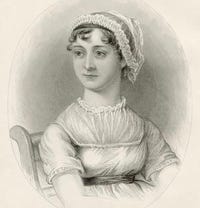And February's book is... Pride and Prejudice!
We'll be reading Pride and Prejudice by Jane Austen this February.
Hello!
Thanks to all of you who took part in the Of Mice and Men discussion. I hope those of you who took part found it valuable. If you’d like to share any more thoughts, please do feel free to even if you missed the original chat.
Having closed the voting, I wanted to let you know that you’ve voted Pride and Prejudice by Jane Austen as your February 2025 novel with 54% of the vote.
We’ll be discussing this one in full on Sunday 2nd March in the Substack chat.
This month, I might look to split the discussion up slightly. We’ll still get together on Sunday 2nd March to have a broader discussion, but I’ll put a couple of discussion pointers in the chat throughout the month so you can share thoughts while reading, as well as at the end!
Let me know if you need any help finding a copy. I’d always recommend buying second hand to save money but I know you can get really gorgeous special editions of Pride and Prejudice if you’d like to feel a little fancy.
I’ve found a PDF version here too if you’re struggling to find access anywhere.
What’s Pride and Prejudice about about?
Taken from Goodreads:
Since its immediate success in 1813, Pride and Prejudice has remained one of the most popular novels in the English language. Jane Austen called this brilliant work "her own darling child" and its vivacious heroine, Elizabeth Bennet, "as delightful a creature as ever appeared in print." The romantic clash between the opinionated Elizabeth and her proud beau, Mr. Darcy, is a splendid performance of civilized sparring. And Jane Austen's radiant wit sparkles as her characters dance a delicate quadrille of flirtation and intrigue, making this book the most superb comedy of manners of Regency England.
Who was Jane Austen?
I took this brief biography from Goodreads to give you a little bit of an idea about Austen’s life and work. I’ll be sharing more about her in the weeks ahead.
Jane Austen was an English novelist known primarily for her six novels, which implicitly interpret, critique, and comment upon the British landed gentry at the end of the 18th century. Austen's plots often explore the dependence of women on marriage for the pursuit of favourable social standing and economic security. Her works are an implicit critique of the novels of sensibility of the second half of the 18th century and are part of the transition to 19th-century literary realism. Her deft use of social commentary, realism and biting irony have earned her acclaim among critics and scholars.
The anonymously published Sense and Sensibility (1811), Pride and Prejudice (1813), Mansfield Park (1814), and Emma (1816), were a modest success but brought her little fame in her lifetime. She wrote two other novels—Northanger Abbey and Persuasion, both published posthumously in 1817—and began another, eventually titled Sanditon, but died before its completion. She also left behind three volumes of juvenile writings in manuscript, the short epistolary novel Lady Susan, and the unfinished novel The Watsons.
Since her death Austen's novels have rarely been out of print. A significant transition in her reputation occurred in 1833, when they were republished in Richard Bentley's Standard Novels series (illustrated by Ferdinand Pickering and sold as a set). They gradually gained wide acclaim and popular readership.
In 1869, fifty-two years after her death, her nephew's publication of A Memoir of Jane Austen introduced a compelling version of her writing career and supposedly uneventful life to an eager audience. Her work has inspired a large number of critical essays and has been included in many literary anthologies. Her novels have also inspired many films, including 1940's Pride and Prejudice, 1995's Sense and Sensibility and 2016's Love & Friendship.




I must admit, teaching this book was a pleasant surprise. I’d always remembered Mark Twain’s comment “that it seemed a shame she was allowed to die a normal death.” But my students loved it and I enjoyed it, too. It got so by the end of the novel, kids in the class were identified by the names of characters. Fun.
Reading this now!